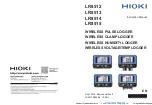
NOVUS AUTOMATION
1/7
LogBox-AA
ELECTRONIC DATA LOGGER - MANUAL V1.1x D
PRESENTATION
LogBox-AA
is an electronic data logger with two analog input
channels. Values measured by these channels (data) are stored in
the logger electronic memory (acquisitions) for later download to a
PC for visualization and analysis in the form of tables or graphs. Data
can be easily exported to spreadsheets.
The
LogChart-II
is the software used to configure the logger,
download and visualize data. The logger configuration allows define
the logger operation mode, including the start/stop time of data
acquisition. Other parameters such as signal input type, Logging
interval, etc., are easily selected through the
LogChart-II
software.
The
LogBox-AA
also provides a signal for commanding an external
power supply (battery) of a device connected to the logger. This
feature allows that external devices, such as a transmitter, be
powered only during the measurement sample time, thus extending
the service life of these external batteries.
MEMORY CAPACITY
Two memory storage capacities are offered: 32 K or 64 K records:
32 k Model: Allows up to 32.000 records;
64 k Model: Allows up to 64.000 records.
Memory capacity is always shared between enabled channels. In
case there are two channels enabled, each gets 50 percent of the
memory available. When only a single channel is enabled, it has the
entire memory at its disposal.
Memory capacity is indicated on the identification label placed on the
logger case.
Fig. 1
–Identification label
INPUT SIGNALS
The input channels 1 and 2 measure analog electric signals, which
can be Pt100, Thermocouple (J, K, T, E, N, R, S or B), voltage (0 to
50 mV or 0 to 10 V) or current (0 to 20 mA or 4 to 20 mA), according
to user-defined settings.
Note: Besides configuration performed through the software, the
definition of input signal requires two internal jumpers to be
configured.
DATA ACQUISITION (LOGGING)
Data can be acquired through different modes. The logger can be
configured to perform a single measurement within a time interval
storing the value read or perform ten measurements within the time
interval and store the mean of values measured. Yet, it can store the
minimum or maximum values read in the interval.
OPERATION
The logger operation mode is user-defined in the
LogChart-II
software. To access or change this configuration, the
IR-LINK3
interface is required
.
The user must
install the LogChart-II software in
a computer and run the logger configuration according to instructions
defined in the LogChart-II installation section of this manual.
After configuration and input electric connections are made, the
device is ready to measure and log input signals. The status indicator
shows the logger current status.
STATUS INDICATORS (LEDS)
The Status Indicators (see
Fig. 2
) are located in the logger front
panel. They indicate the current working conditions of the unit.
LOG Indicator
(
Logging)
: While in stand-by (not logging) or after
a series of acquisitions is ended, it flashes once at every four
seconds. During login it flashes twice at every four seconds.
AL Indicator (
alarm
):
Alerts the user regarding alarm conditions.
Whenever an alarm situation takes place it will flash once at every
four seconds, until a new configuration is applied to the logger.
Fig. 2
– LED Indicators and IR communication
LOGCHART-II
INSTALLING LOGCHART-II
The LogChart II is the software provided with the logger to allow for
configuration and data collection. To install the LogChart II, execute
the
LC_II_Setup.exe
program provided in the CD. The installation
wizard will then guide you throughout the installation process.

























